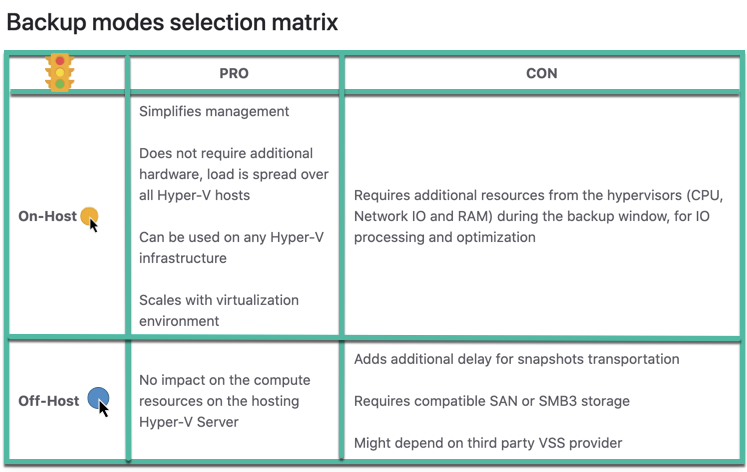Veeam Backup and Replication provides two different backup modes to process Hyper-V backups, both relying on the Microsoft VSS framework.
- On-Host backup mode, for which backup data processing is on the Hyper-V node hosting the VM, leveraging non transportable shadow copies by using software VSS provider.
- Off-Host backup mode, for which backup data processing is offloaded to another non-clustered participating Hyper-V node, leveraging transportable shadow copies using hardware VSS provider provided by the SAN storage vendor or SMB3 functionality

Performance wise, since both backup modes are using the exact same Veeam transport services, the only differentiating factors will be the additional time requested to manage transportable snapshots (in favor of On-Host mode) and the balance between compute and backup resources consumption during backup windows (in favor of Off-Host mode).
When using Windows Server 2016 or later, On-Host proxy mode is very fast and requires less components, thus reduces complexity. However, the Veeam data mover agent will consume host compute resources for deduplication and compression, so this needs to be considered when planning the Veeam Job design. Please be aware that you will need up to 2GB of RAM on the Hyper-V Host per running task (one task = backup of one virtual disk). This memory must be available for running backup jobs, otherwise the Hyper-V Host will start paging, which will result in an overall slow system
 Limiting the impact of On-Host backup mode on the production infrastructure
Limiting the impact of On-Host backup mode on the production infrastructure
While consuming production resources for backup purposes, the On-Host backup mode disadvantages can be mitigated by the following guidelines.
-
Spreading load across hypervisors. It should be kept in mind that the backup load, instead of being carried by a limited number of dedicated proxies, will be spread over all Hyper-V hosts. When needing 16 proxy task slots to meet the backup window, in a cluster of 8 hosts each hosting the same amount of proteced VMs will result in a task limit configuration of 2 per host thus limiting the impact per host.
-
Leveraging storage latency control. This feature allows to protect the volumes (globally for Enterprise edition, and individually for Enterprise Plus edition) from high latency, by monitoring and adjusting backup load accordingly
 which one do you use in your Hyper-v Infrastructure?
which one do you use in your Hyper-v Infrastructure?




